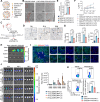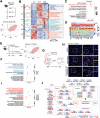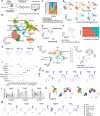Targeted immunotherapy rescues pulmonary fibrosis by reducing activated fibroblasts and regulating alveolar cell profile
- PMID: 40258811
- PMCID: PMC12012202
- DOI: 10.1038/s41467-025-59093-7
Targeted immunotherapy rescues pulmonary fibrosis by reducing activated fibroblasts and regulating alveolar cell profile
Abstract
Idiopathic pulmonary fibrosis (IPF) is a severe lung disease occurring throughout the world; however, few clinical therapies are available for treating this disorder. Overactivated fibroblasts drive abnormal fibrosis accumulation to maintain dynamic balance between inflammation and extracellular matrix (ECM) stiffness. Given pulmonary cell can regenerate, the lung may possess self-repairing abilities if fibrosis is removed via clearance of overactivated fibroblasts. The aim of this study was to evaluate the therapeutic activity of transient antifibrotic chimeric antigen receptor (CAR) T cells (generated via a novelly-designed lipid nanoparticle-messenger RNA (LNP-mRNA) system) and explore the regeneration mechanisms of lung in a male mouse model of bleomycin-induced pulmonary fibrosis. Here we found that fibrosis-induced ECM stiffening impaired alveolar epithelial cell compensation. The proposed LNP-mRNA therapy eliminated overactivated fibroblasts to rescue pulmonary fibrosis. The restored ECM environment regulated the cellular profile. The elevated plasticity of AT2 and Pclaf+ cells increased AT1 cell population via polarization. Apoe+ macrophages and increased numbers of effector T cells were shown to reestablish pulmonary immunity. Hence, LNP-mRNA treatment for fibrosis can restore pulmonary structure and function to similar degrees to those of a healthy lung. This therapy is a potential treatment for IPF patients.
© 2025. The Author(s).
Conflict of interest statement
Competing interests: The authors declare no competing interests.
Figures








Similar articles
-
Allium sativum nanovesicles exhibit anti-inflammatory and antifibrotic activity in a bleomycin-induced lung fibrosis model.Mol Biol Rep. 2024 Nov 19;51(1):1166. doi: 10.1007/s11033-024-10104-8. Mol Biol Rep. 2024. PMID: 39560703
-
TWEAK-Fn14 signaling protects mice from pulmonary fibrosis by inhibiting fibroblast activation and recruiting pro-regenerative macrophages.Cell Rep. 2025 Feb 25;44(2):115220. doi: 10.1016/j.celrep.2024.115220. Epub 2025 Jan 18. Cell Rep. 2025. PMID: 39827460
-
Therapeutic effects of MEL-dKLA by targeting M2 macrophages in pulmonary fibrosis.Biomed Pharmacother. 2024 Sep;178:117246. doi: 10.1016/j.biopha.2024.117246. Epub 2024 Aug 3. Biomed Pharmacother. 2024. PMID: 39096617
-
Lung Fibroblasts, Aging, and Idiopathic Pulmonary Fibrosis.Ann Am Thorac Soc. 2016 Dec;13 Suppl 5:S417-S421. doi: 10.1513/AnnalsATS.201605-341AW. Ann Am Thorac Soc. 2016. PMID: 28005427 Review.
-
Pharmacological targeting of ECM homeostasis, fibroblast activation and invasion for the treatment of pulmonary fibrosis.Expert Opin Ther Targets. 2025 Jan-Feb;29(1-2):43-57. doi: 10.1080/14728222.2025.2471579. Epub 2025 Feb 27. Expert Opin Ther Targets. 2025. PMID: 39985559 Review.
Cited by
-
Comprehensive analysis of molecular characteristic and clinical prognosis of CD8+ T cell related genes in idiopathic pulmonary fibrosis.PLoS One. 2025 Jul 31;20(7):e0328250. doi: 10.1371/journal.pone.0328250. eCollection 2025. PLoS One. 2025. PMID: 40743122 Free PMC article.
-
Treatment Strategies for Acute Exacerbation of Interstitial Lung Disease Associated with Systemic Autoimmune Rheumatic Diseases in Chinese Patients: A Scoping Review.Rheumatol Ther. 2025 Jul 21. doi: 10.1007/s40744-025-00785-3. Online ahead of print. Rheumatol Ther. 2025. PMID: 40690164 Review.
References
MeSH terms
Substances
LinkOut - more resources
Full Text Sources
Medical
Research Materials
Miscellaneous

